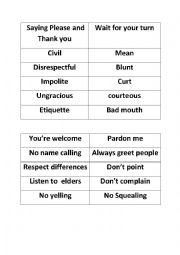


They will find it easy to get along with people, succeed at work or school, and develop good relationships with others around them. Good manners are basic elements that will instil a sense of etiquette in your children and make them better human beings when they grow up. Make it a rule at home, and your child will naturally imbibe these good manners. Repeatedly use them with your child and encourage them to use these words with you as well. The words, ‘please’, ‘thank you’, ‘sorry’, ‘excuse me’, and ‘may I’ are the first few words that should be taught to a child when teaching him or her good manners. Teach your kids to judge a person solely by their character and not by anything else. If you are teaching your kids to be respectful to people of other religions, groups, gender and nationalities, make sure not to carry the same biases yourself.If you are calm and firm, your child will respond in the same way as well. It is important to never lose your temper and get angry at your child. Children will frustrate you many times with their short attention span and active mind, but be patient.However, if your child is very sensitive, you can talk in private later. Even if it is in the middle of a conversation with someone else, and your child interrupts, take a moment to stop and gently correct him/ her. Good manners refers to polite, humble, courteous, respectful and well-cultured social behavior, which is strongly depended on the tradition and background of. Correct your child on the spot when he/ she does something wrong.Ignoring your child’s good manners may have a reverse effect, as they may resort to misbehaviour to get your attention. Children love praise, and encouraging them each time they are good will help them want to be better. When your child does something right or displays a good habit, make sure to encourage him/ her with words of positive enforcement.Manners like being polite, knocking on doors, cleaning up after one’s self, dining table etiquette, and so on, can be practised at home with your kids repeatedly, until it gets fixed in their minds and behaviour.Even in moments of frustration, don’t let your manners slip in front of your children. If you want your child to have good manners, make sure to practice what you preach in front of them. Children look up to parents as role models. The first step is to have all those good manners yourself.


 0 kommentar(er)
0 kommentar(er)
